
Caring for Tennis Courts
From Everyday Maintenance to Professional Resurfacing Requirements and Beyond
by Adia Walker / Published Apr 2014
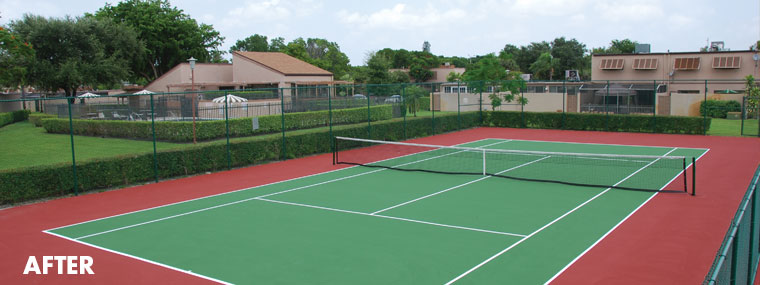
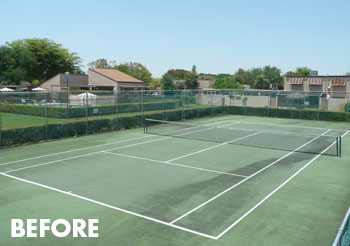
The maintenance involved in community associations is varied and never ending. To successfully keep your community looking and functioning its best, sometimes you need to consult with the experts. This month, we are providing insight on how to maintain tennis courts; seeking a qualified professional’s advice, we spoke with Trimmer Dettor, Vice President/Owner of Fast-Dry Courts and 10-S Tennis Supply. Dettor grew up playing tennis and is currently a United States Professional Tennis Association (USPTA) Tennis Pro, so he has a well-rounded interest in the subject. In this article, he provides answers to some common questions.
Why is Regular Maintenance of Tennis Courts Important for Community Associations?
- “It’s very important that community associations keep up their tennis courts and surrounding areas because it’s a reflection of the community,” says Dettor. “When people come to look at the community, if they see that the tennis court is in bad shape, they will think it reflects the condition of the rest of the community.”
- Regular maintenance will also help you keep the costs of repairs down. “The longer you wait to fix any issues the more expensive it will be,” says Dettor. “If you wait 10 or 15 years, the inherent properties of your court can be compromised. Regular maintenance is a way to protect your investment.”
How Do I Know if it’s Time to Resurface Our Tennis Court?
- Court colors are fading.
- There are low areas that are discolored, mildewed, or hold water long after a rain.
- There are wide cracks affecting ball bounces or creating a safety hazard.
- It’s been four to six years since the court was last resurfaced. “Generally, most community associations have hard courts also known as asphalt courts on their property,” says Dettor. “Hard courts should be resurfaced every four to six years.”
What is the Best Way to Obtain a Quote?
- “First, you have to call a licensed contractor to come and inspect the court,” says Dettor. “You can’t just call up a company and get a price; it has to be inspected for the quote to be correct.”
- “Qualifying the contractor you get to do the quote is very important,” adds Dettor. “There are a lot of people that do what we do, but not everyone is qualified to do the work or has a track record of success. When comparing quotes, you need to compare apples to apples. Always make sure you check the company’s qualifications, including licenses, insurance, and references.”
- Get as much information as possible, know all your options, and be aware of your budget. “I like to provide the customer with everything I recommend they do, but I also give them as many options as possible to work with their budget,” says Dettor.
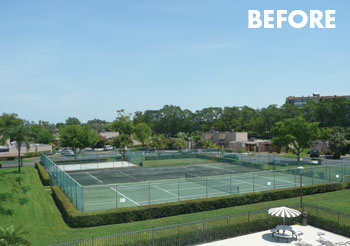 What Will the Contractor Want to Know/Look for During an Inspection?
What Will the Contractor Want to Know/Look for During an Inspection?
- When the court was originally built
- When it was last resurfaced
- General condition of the court
- The number and linear feet of cracks in the surface
- Any low areas
- Root intrusion
- The condition of the net posts
- The condition of net post concrete foundations
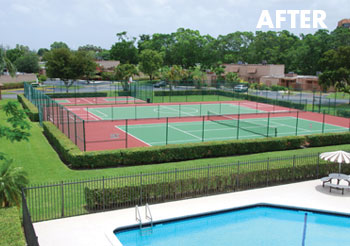
What Goes into the Process of Resurfacing?
- Pressure cleaning and/or grinding any court areas that have excessive dirt, grime, or algae
- Patching any low lying areas or sections that had to be cut away due to tree roots
- Repairing the cracks and possibly installing a fiberglass membrane to keep cracks from returning to the surface
- Applying one to three coats of acrylic court resurfacer to fill in minor imperfections and seal the surface
- Applying one to three coats of acrylic court paint and playing lines for the finished surface
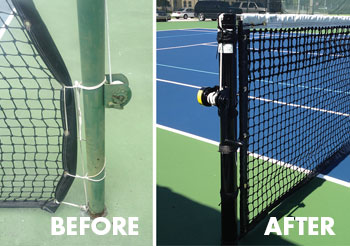
What are Some Other Maintenance Items to Consider in Addition to Resurfacing the Court?
- Windscreen installation—consider adding a multi- functional windscreen that displays your community association’s name while protecting your court from the wind.
- Fencing replacement or refurbishment—make sure the surrounding fence looks as nice as your court.
- Root barrier installation— being proactive can help eliminate costly repairs in the future.
- Court accessories—benches and court organizers add convenience for your members.
- Net post and/or net post foundation repair—these posts are an important structural element of the court as well.
- Lighting—both light posts and the bulbs will need regular maintenance.
- Water removal equipment—make sure you are using the right tools to keep your court clean and dry.
What Steps Can We Take to Minimize the Wear and Tear on Our Courts?
- Post signs that alert players to use tennis shoes only; colored soles or hard shoes will create permanent scuff marks.
- Do not allow roller blades, skateboards, bicycles, etc. on the court’s surface. Asphalt is softer than concrete and permanent marks will occur.
- If small chips develop, patch with a combination of pure acrylics and silica sand (a tennis supply store can provide this).
- Place mat at entrance to remove debris from shoes prior to entering.
- Remove sand, leaves, pine needles, etc. from the surface regularly using a broom or a blower.
- Remove excess standing water as soon as possible after rain to prevent mildew/algae growth.
- Mildew/algae can develop from standing water and shade. They can be removed by pressure washing with water.
- Small areas can be cleaned with cold water and non-sudsing detergent (30 percent household bleach mixed with 70 percent water) or by using specific cleaner sold at tennis supply companies.
- Sprinkler systems and lawn fertilizers will stain courts.
- Tables or chairs with sharp legs may damage the asphalt. Use a court bench created specifically for tennis courts only.
- Most roots will feed on the nitrogen content in the asphalt. Do not plant vegetation close enough that roots will eventually damage the court.
- All landscaping around the court should be two inches lower than the asphalt surface for proper drainage.
- Do not allow grass to grow onto the court edge. If this happens, remove the grass immediately. A drain rock border can help solve this.
- Install a Court Organizer on your net post to hold drinks and collect garbage.
- Windscreen ties are designed to break away under high winds to help prevent fence damage. Replace broken ties as soon as possible. Remove windscreen at the threat of high winds of 50 mph or more.
What are Your Final Words of Advice?
- “Don’t let tennis courts go longer than six years without being resurfaced,” Dettor advises. “Our company sends you a letter four years after we do any resurfacing that reminds you to give us a call, and we can come out to see if it’s time to resurface. Oftentimes, board members change and the court ends up being neglected, which results in spending a lot of money for something that could have been maintained. Everyone needs to know how often resurfacing projects should be done; it should be built into their budget.”

